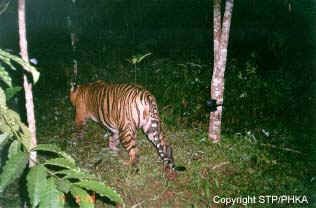Way Kambas National Park
 Way Kambas National is situated on the coast of
Lampung province on the island of Sumatra, Indonesia. Bounded by the
Java Sea to the east, and to the southeast and west by rivers the park
is almost entirely flat (elevation between 0-60 metres a.s.l.). As such
the park is characteristic of the coastal lowland plains of eastern
Sumatra. Approximately 1,300 km2 in extent, the park was originally
established as a wildlife reserve in 1937, but between 1954 and 1974 was
intensively logged.
Way Kambas National is situated on the coast of
Lampung province on the island of Sumatra, Indonesia. Bounded by the
Java Sea to the east, and to the southeast and west by rivers the park
is almost entirely flat (elevation between 0-60 metres a.s.l.). As such
the park is characteristic of the coastal lowland plains of eastern
Sumatra. Approximately 1,300 km2 in extent, the park was originally
established as a wildlife reserve in 1937, but between 1954 and 1974 was
intensively logged.
In 1978 it was proposed as a national park, with
provisional declaration in 1989 and final declaration in 1997.
Much of the park is dominated by a mosaic of Imperata cylindrica grassland and secondary forest habitat types, primarily a result of intensive logging operations in the past, but maintained by frequent fires and seasonal flooding. A central core area of the park is characterised by relatively intact primary tropical rainforest.
Remote camera monitoring, carried out by the Sumatran Tiger Project and the Indonesian Department of Forestry between 1995 and 1999, has shown that the park's mammal biodiversity remains intact. Camera work suggests that between 21 and 36 tigers existed in the park during this period.
Sumatran rhinoceros (Dicerorhinus sumatrensis) previously thought to be extinct within the park, discovered by this project, are estimated to number about 20 individuals
As a model for tiger conservation
Way Kambas National Park is considered an excellent model in which to develop tiger conservation plans across Sumatra. While the mosaic of lowland secondary rainforest and Imperata grassland is quite different to the hilly and forested of the larger Sumatran national parks, the habitat types found in Way Kambas can be considered to be more representative of Sumatra as a whole. Intensively logged on several occasions in the past, the park has been subject to varying degrees of disturbance and, because of this, is currently at different stages of regeneration. Also, the high density of humans in the area surrounding the park is itself a characteristic of the majority of other protected areas in Sumatra where tigers are thought to exist.

Tidak ada komentar:
Posting Komentar